October 9, 2013 - By Krista Conger
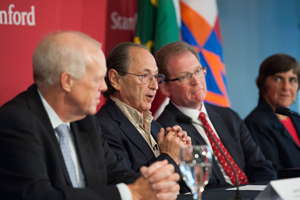
Michael Levitt (second from left) speaks to reporters at an Oct. 9 press conference after winning the Nobel Prize in Chemistry. He was joined by (from left) Stanford President John Hennessy, School of Medicine Dean Lloyd Minor and Jennifer Widom, chair of computer science.
Michael Levitt, PhD, professor of structural biology at the Stanford University School of Medicine, has won the 2013 Nobel Prize in Chemistry.
Levitt, 66, is the second faculty member of Stanford's medical school to win a Nobel Prize this week. On Oct. 7, Thomas Südhof, MD, professor of molecular and cellular physiology, won the 2013 Nobel Prize in Physiology or Medicine.
Levitt, who holds U.S., British and Israeli citizenship, shares the $1.2 million prize with Martin Karplus, PhD, of the University of Strasbourg in France and Harvard University, and Arieh Warshel, PhD, of the University of Southern California, "for the development of multiscale models for complex chemical systems."
Levitt's work focuses on theoretical, computer-aided analysis of protein, DNA and RNA molecules responsible for life at its most fundamental level. Delineating the precise molecular structures of biological molecules is a necessary first step in understanding how they work and in designing drugs to alter their function.
"Like everyone else, one is surprised," Levitt said of receiving the early morning call from Sweden. "Now I just hope to get through the day and make sure that, in the end, my life doesn't change very much. Because I really have a wonderful life.
"My phone never rings," he added. "Everyone sends me texts and email. So when the phone first rang, I was sure it was a wrong number. When it rang a second time, I picked it up. I immediately heard a Swedish accent and got very excited. It was like having five double espressos."
Sharing with friends
Levitt and Warshel worked together in the 1970s in the laboratory of Shneior Lifson, PhD, at the Weizmann Institute of Science in Israel. "We had the idea about doing computer calculations on the large molecules that make life possible," said Levitt, who was relieved to hear the names of the other winners.
"One would hate to win the prize if people who also deserved it didn't get it," said Levitt, who is the Robert W. and Vivian K. Cahill Professorship in Cancer Research at Stanford's School of Medicine. "So I was very pleased to hear their names."
Levitt joined the Department of Structural Biology at Stanford in 1987; he has a courtesy appointment in computer science. He is also a member of Bio-X, a Stanford initiative that unites experts in biology, medicine, chemistry, physics and engineering.
"Michael is a real pioneer in science," said Joseph Puglisi, PhD, professor and chair of structural biology. "He was one of the first people to apply computers to biology, which is a huge field right now. This is such a deserved Nobel Prize. He's also a very dear friend of mine and a wonderful, nice man. It's all that is great about science. I've been waiting for this day for a long time."
Lloyd Minor, MD, dean of the Stanford School of Medicine, said, "I am delighted that Michael Levitt has been recognized with this prize. The Nobel Prize in Chemistry is perfectly fitting for Mike's contributions to chemistry and medicine and a clear example of the value of basic theoretical research to practical medicine. Today we take computer modeling in biology for granted, but Dr. Levitt was one of its pioneers, using it to predict the shapes of important biological molecules. Thanks to his agile mind, not to mention his boundless energy, curiosity and collegiality, he effortlessly crosses the disciplines of computer science, physics and biology to carry out this foundational work in computational biology. He himself is a perfect model of the type of interdisciplinary scientist that makes Stanford Medicine great."
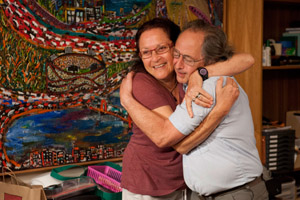
Levitt hugs his wife, Rina, who is an artist.
(High-resolution images for download.)
Stanford President John Hennessy, PhD, agreed. "This is the strength of the research being done at Stanford, where today we mark the 10th anniversary of the Clark Center and Bio-X, the interdisciplinary initiative of which Mike is a member," Hennessy said. "The Nobel Prize is not only fitting recognition of the significance of Mike's work to medicine, and another extraordinary honor for Stanford, it is further proof of the success and impact of interdisciplinary collaboration."
Blazing a trail
Levitt's early work pioneered computational structural biology, which helped to predict molecular structures, compute structural changes, refine experimental structure, model enzyme catalysis and classify protein structures. His basic research set the stage of most subsequent work in the rapidly growing field. It also led to practical methods for antibody humanization that are key for modern anticancer therapy, such as the drug Avastin.
Roger Kornberg, PhD, professor of structural biology and the Mrs. George A. Winzer Professor in Medicine, got an early morning phone call at home from an excited Levitt. "Michael is one of my closest friends in the world," said Kornberg, who won the Nobel Prize in Chemistry in 2006 and who has known Levitt since the two studied together at Cambridge in the early 1970s. They also have co-authored many papers.
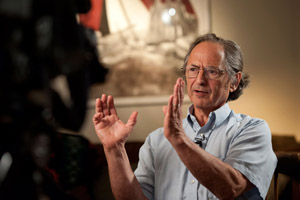
Michael Levitt speaks to reporters at his home Oct. 9 after winning the Nobel Prize in Chemistry.
(High-resolution images for download.)
"He has long deserved it, and so, of course, I hoped he would win the prize, but one never knows," Kornberg added. "I regard Michael as the founder of computation biology, the leading figure in the field. He is a gem of a person. You will never find a more generous or modest individual."
Levitt's early work in the late 1960s set the stage for an entirely new way to predict how proteins fold and interact. At that time, X-ray crystallography was used to ascertain the location of atoms like hydrogen, carbon and oxygen in larger molecules like proteins or DNA. Researchers then used the data to construct very large three-dimensional models out of plastic balls and metal sticks in order to better understand what the molecules looked like and how they might work.
"Molecules work because of their structure," Levitt said. "And cells worked because of where things are placed inside. The only way to interfere is to first learn their three-dimensional structure. If you wanted to change a city, but had no idea of where the buildings are, you would have no idea where to start."
In 1967, Levitt and Warshel first designed a computer program that used traditional, Newtonion physics to describe the resting structure of large molecules based on their amino acid sequences. Warshel and Karplus used this program as a launching point to develop a new computer algorithm that also incorporated the principles of quantum physics. (Although quantum physics is better at explaining the atomic forces working on a molecule during chemical reactions, the calculations require immense computing power.) In 1976, Levitt and Warshel published the first computerized model of an enzymatic reaction.
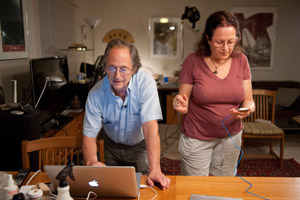
Levitt and his wife, Rina, answer emails and phone calls from friends.
(High-resolution images for download.)
Levitt credits his family, particularly his wife of 45 years, Rina, an artist, for supporting him. "I am a very passionate scientist, but passionate scientists often make very bad husbands," he said. He and his wife have three sons and three grandchildren.
Levitt was born in 1947 in Pretoria, South Africa, and was raised there until he went to London to attend King's College to obtain a degree in physics. But then there was a hitch in his plans.
"Enthralled by John Kendrew's BBC 1964 television series The Thread of Life, I wanted desperately to do my PhD at the Medical Research Council in Cambridge," Levitt wrote in 2001 in an article in Nature Structural Biology. "Alas, there was no room for any new postgraduate students in 1967!"
Kendrew had received the Nobel Prize in Chemistry in 1962 for determining the structure of myoglobin using X-ray crystallography; The Thread of Life was an introduction to the concepts of molecular biology.
The program at Cambridge was full, however, but he was accepted to attend the following year. In the interim, he went to study in the laboratory of Shneior Lifson, PhD, at the Weizmann Institute, where his fellow Nobel laureate Arieh Warshel was then a PhD student. At the institute, he was immediately plunged into the relatively new fields of structural biology and computers.
Building Golem
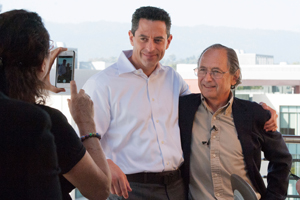
Rina Levitt takes a photo of her son, Daniel, with her husband, Michael, after the press conference for Michael Levitt's Nobel Prize.
(High-resolution images for download.)
"I was in my 20s. Someone handed me a programming manual and asked me to write a program," Levitt said. He, Warshel and Lifson were working on a way to predict the energy of molecular structures and the forces that act upon them as they assume three-dimensional states. The computer at the institute, a machine custom built in 1963, was called Golem, after an inanimate creature in Jewish folklore. It cost $10 million to build.
"Whereas computers now have memory capacities measured in gigabytes, the memory of my first machine was less than one megabyte," Levitt said. "Nothing is that slow. It was thousands of times less than the cheapest machines today."
Levitt feels the computer industry deserves a large part of the credit for the work he's been able to accomplish throughout his career.
"Computers and biology go together. Biology is very complicated, and computers are such wonderful, powerful tools. And they just keep getting more and more powerful."
Proteins consist of strings of molecules called amino acids, like beads on a necklace. Unlike a necklace, however, proteins don't coil upon themselves passively but instead assume specific three-dimensional shapes governed by the interactions among the atoms of their amino acids — some of which attract each other and some of which push one another away. Laws of chemistry and physics dictate that a resting protein molecule will assume a conformation that balances these push-pull forces in a way that minimizes its energy state. These laws also affect how two or more molecules interact to carry out enzymatic interactions or other biological interactions.
"Proteins are not just good to eat, but they have specific shapes," Levitt said. "Although they consist of many thousands of atoms, they are governed by the same laws that govern the structure of bridges and houses. Everything is highly organized."
Uniting computational chemistry and biology
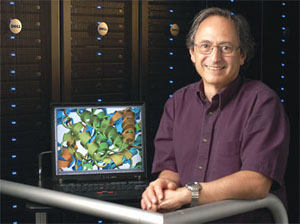
Levitt's work focuses on theoretical, computer-aided analysis of the protein, DNA and RNA molecules responsible for life at its most fundamental level.
Working together, Levitt and Warshel designed a computer program that was capable of performing the first energy-minimization calculations for entire protein structures. The first two proteins they analyzed were myoglobin and lysozyme. In 1969, Warshel took the computer program with him to the laboratory of Martin Karplus, PhD, at Harvard University. Karplus and others then refined the program, integrating the principles of quantum physics in order to simulate protein dynamics, an advance that Levitt credited in the Nature Structural Biology article with moving the field of computational chemistry into the field of biology.
Levitt earned his PhD from Cambridge University in 1972, where he studied the structure of a molecule called transfer RNA, which helps build proteins inside the body, using the bulky, three-dimensional ball-and-stick model popular at the time.
"Transfer RNA has almost 2,000 atoms and a space-filling model weighs over 100 pounds. My most vivid memory is lowering the tRNA CPK model from the first floor window of our terrace cottage in Newnham, while my somewhat pregnant wife was having a hard time controlling her laughter," recalled Levitt in the Nature article. There had to be a better way.
Levitt returned to the Weizmann Institute as a postdoctoral scholar from 1972 to 1974. He studied with Francis Crick at the Salk Institute from 1977 to 1979, then returned to the Weizmann Institute as a faculty member until coming to Stanford in 1987.
"This is wonderful news," said Axel Brunger, PhD, professor and chair of molecular and cellular physiology, as well as professor of neurology and neurological sciences at Stanford. "He's made so many important contributions to computational biology, including the first computer simulations of proteins. His work has helped many scientists, including myself in my work."
"I went to sleep last night very excited about the work that's been done in my lab this week," said Levitt. "Yesterday someone in my lab devised a new way to do a calculation thousands of times faster than before. When something becomes so fast, it opens up whole new possibilities. So, of course I'm excited about the Nobel. But I am passionate about my research. Passion is really important for anything you do; it's a general requirement."
One of the first things Levitt did after learning of the award was to update the status on his Facebook page. "That was the most important thing," he said, joking. He also called his mother, Gertrude, 98, who lives in London. "She was very happy," said Levitt. "I am hoping she can come to Stockholm with me."
Gertrude Levitt said her son was a "busy child" who liked to build Lego models. "He was very keen on taking things to pieces and putting them together. He liked to explore," she said in a telephone interview this morning. He would tape record himself reading his books, then play the recordings back in bed at night, hoping to learn while he was asleep, she said.
He also liked to blow things up. "I would always find tins flying across the garden," she said, explaining that he would turn the tins upside down and place an explosive concoction of chemicals underneath them. "He took glycerin and potash and mixed them together and put them on my beautiful parquet floor. I wasn't very pleased. He blew a hole in the floor."
Levitt eschews titles, including doctor or professor. "Call me Michael, or Mike," he insists. He and his wife together designed a two-dimensional wire sculpture for the 2013 Burning Man festival in Nevada. Rina, the artist, designed the piece, called Unity. Levitt, of course, used a computer to calculate the exact shape and dimensions the single long wire outline should assume.
About Stanford Medicine
Stanford Medicine is an integrated academic health system comprising the Stanford School of Medicine and adult and pediatric health care delivery systems. Together, they harness the full potential of biomedicine through collaborative research, education and clinical care for patients. For more information, please visit med.stanford.edu.